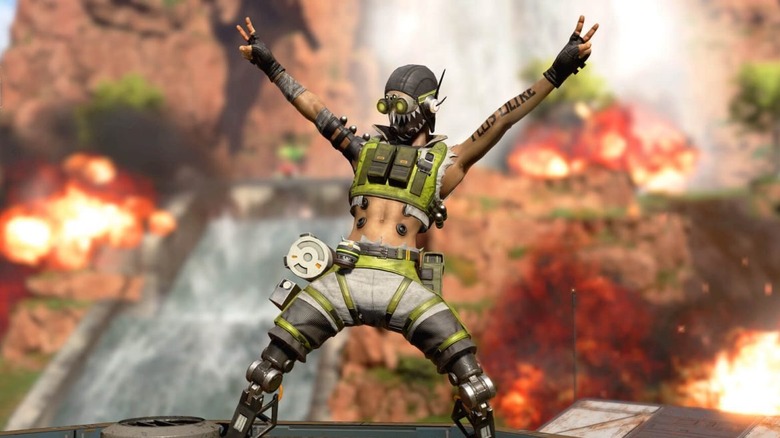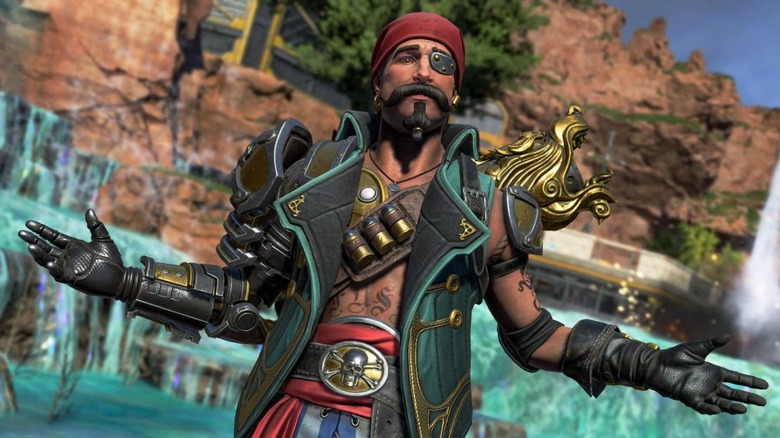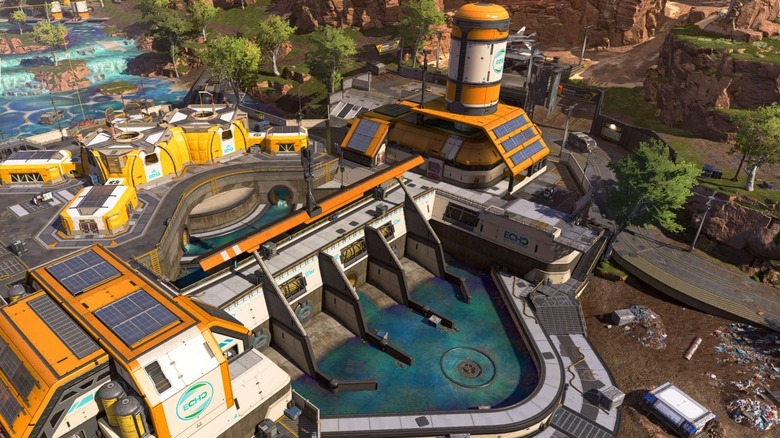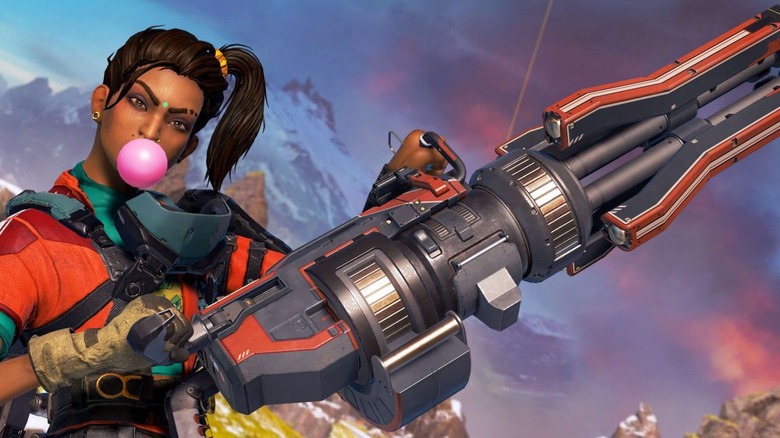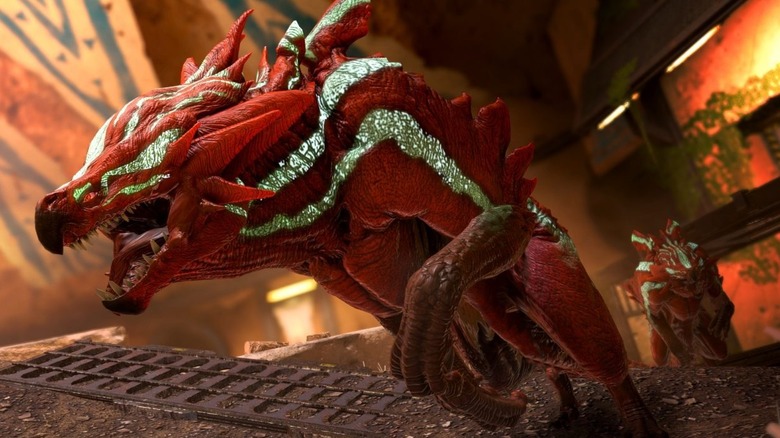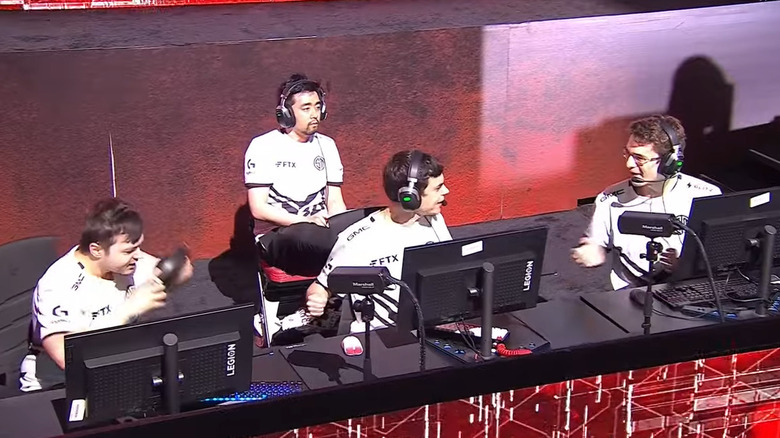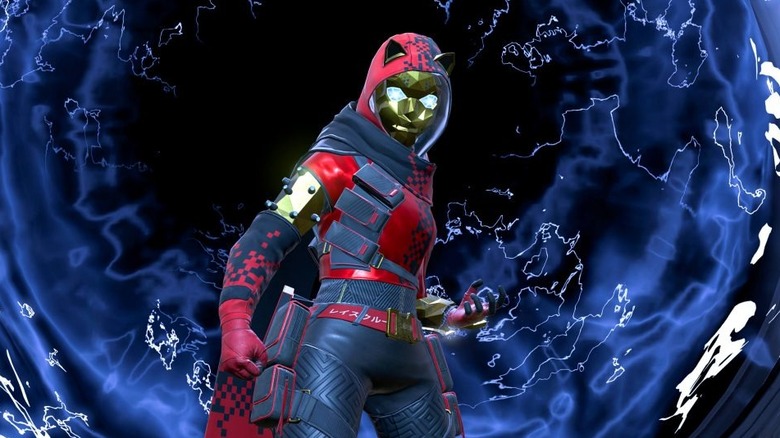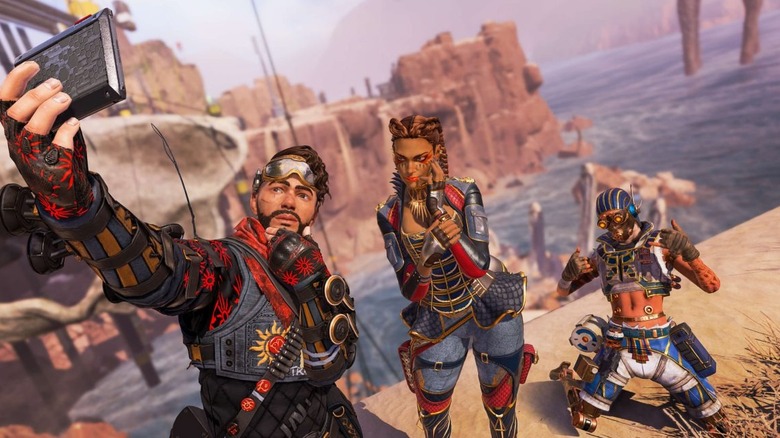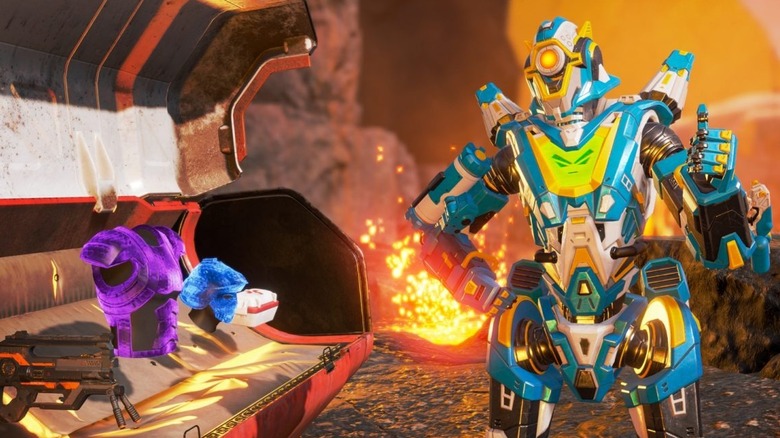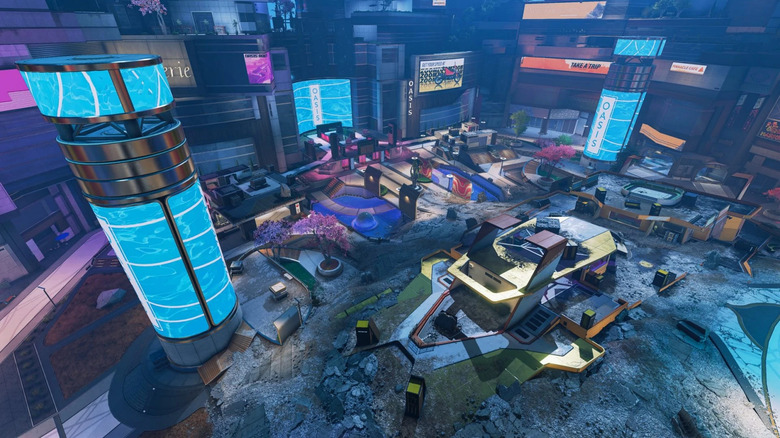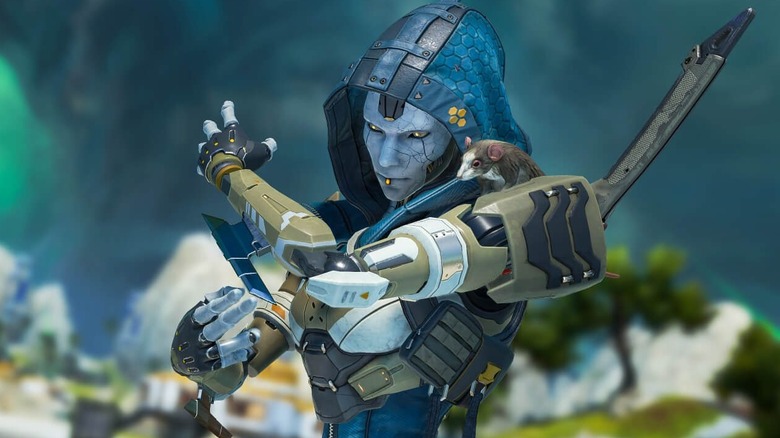Apex Legends Isn't The Same Game As When It First Started
Released as a smash-hit Battle Royale in 2019, "Apex Legends" has remained a top FPS title throughout its short life span. It was released with minimal marketing, out of the dark, from Respawn Entertainment and it took the gaming world by storm. Within 72 hours of launching "Apex Legends" had more than 10+ million players, and within its first month, it had achieved more than 50+ million players, according to a Unity blog.
As a free-to-play title, "Apex Legends" had no problems getting players into its lobbies. Fans of the series praised the game's fluid movement, logical loot system, snappy gun combat, and range of playable legends (per Game Informer). In order to turn a profit on its strong core audience, Respawn has opted for a Games-as-a-Service model for "Apex Legends," meaning that the game is constantly updated with new purchasable content and rebalancing changes.
When every new Season brings gameplay balances, new playable legends, new maps, new guns, and new game mechanics, then change comes quickly. What players are familiar with one season doesn't necessarily translate to the next. So, let's take a look at exactly what did change in "Apex Legends" over the years.
A Titanfall Expansion?
"Titanfall 2," the sequel to the lauded, mech-flavored FPS "Titanfall," was released in 2016. Respawn Entertainment, the developers behind the game, looked to immediately expand upon Titanfall 2's success by working on DLC expansions.
In this DLC development stage, the employees of Respawn found themselves enjoying one mode in particular above the rest: Survival Mode (per EA). As is the basis in the Battle Royale genre, Survival Mode pitted a lobby of players against each other in a winner-takes-all, free-for-all format. This Survival Mode opted for a team-based approach where players formed their 3-person squad during the lobby by jumping into the same dropship together.
The more Respawn played Survival Mode the more they realized they had something special on their hands. They even had a chalk leaderboard posted in their office to keep track of how many chicken dinners (victories) each employee earned. More resources and further development was dedicated to this mode, which would go on to become its own title, "Apex Legends."
New Legends Every Season
A major selling point for "Apex Legends" — the reason it stands out within the crowded battle royale genre — is that it is a hero-shooter. This asymmetrical basis is also part of what made other FPS titles like "Team Fortress 2," "Overwatch," and "Valorant" so popular. Players are enabled to pick heroes that suit their desired playstyles while also personally connecting with their character or aesthetics.
Balancing a game with a fixed pool of heroes is hard enough; once new heroes are added to the existing pool, then the game gets far more complex. So, adding new heroes is no small act. "Apex Legends" launched with 8 playable heroes (legends) and, ever since, they have stuck to their ambitious goal of adding 1 new legend every new season. Apex Legends is in its 14th season currently, and there now, accordingly, 22 playable legends.
The game's new additions run the gambit in terms of variety — there's astronaut assaulters like Horizon, stalwart defenders like Newcastle, and also characters from "Titanfall 2" such as Ash. However, not all legends have been released in a balanced state. When Seer came out in Season 10, his abilities were so strong that many players complained that he was breaking the game. Rough introductions aside, "Apex Legends" has done well to keep adding new flavors to their Battle Royale experience with new legends every season.
Ever Expanding Maps
When "Apex Legends" released in 2019, it only came with one map – Kings Canyon. This was the map that housed the Survival Mode trials when "Apex Legends" was still a "Titanfall 2" expansion. Roaming around Kings Canyon in "Apex Legends" felt different than other Battle Royale titles of the time due to its superb movement controls. Sliding down Kings Canyons' slopes with increased speed, or flying above it all after launching from a zipline-separated "Apex Legends" map with crisp, novel mechanics.
The second map, World's Edge, was added to the rotation in Season 3, in 2019. World's Edge introduced a volcanic and arctic-themed land with geysers that shoot players across the desolate landscape as well as a now-shut-down train system. After that, Olympus was released in Season 7 in 2020. A floating utopian city, Olympus is the most visually cohesive map released, and it makes heavy use of teleportation rings. Lastly, Storm Point was released in Season 11 in 2021 as a tropical-themed land more heavily populated with PvE monsters than any other map.
On top of their consistent expansion of the map roster, Respawn has also changed many elements of the existing maps. Most notably, the original map, Kings Canyon, has undergone the most changes with almost every new legend impacting something on the storied landscape. World's Edge has likewise undergone many changes over the years, and Respawn Entertainment has proven its dedication to building out "Apex Legend's" maps.
Guns and Bows and Lasers
Any good FPS game will have an arsenal of satisfying weapons for its players to choose from, and "Apex Legends" is no slouch. Separated by ammo type and traditional archetypes (assault rifles, sub-machine guns, sniper rifles, shotguns, and pistols), the weapons of "Apex Legends" are one of its strong suits due to their variety and specialized effectiveness at different jobs.
Upon launch in 2019, "Apex Legends" had 20 available weapons with some of them only available to players through late-game supply drops. The Wingman has consistently stood out amongst other weapons to the ire of some Reddit and Youtube community members for years. Its most recent nerf, changing its ammo type from heavy to sniper ammo, hasn't slowed down its effectiveness much. Other weapon combos like the R-400 have been popular throughout the years and their meta-defining qualities drive many weapon-based balance changes.
Later additions to "Apex Legends" include exotic fan favorites like the Bocek Compound Bow and new-old-reliables like the Volt. Other new additions have innovated the capabilities of weapons in "Apex Legends," like the Rampage, which can be charged with a Thermite grenade, or the Charge Rifle that introduced laser-charge sniping to the game. New weapon hop-ups have also added the customization options of existing weapons.
"Apex Legends" also added in Legendary Weapons that come fully kitted with un-swappable legendary attachments in every slot. Funnily enough, players have complained enough about certain 'legendary' attachment combinations that Respawn capitulated and changed the scopes.
Introduction of PvE Content
The main focus of Battle Royale games is certainly its PvP content. Most of the enjoyability of competitive games comes from, well, competing. But "Apex Legends" isn't just a competitive game. It also has accompanying lore, and Respawn Entertainment has begun pushing the envelope of incorporating that lore into the gameplay itself.
Back in Season 5, Bloodhound received a personalized mission on World's Edge, called "Bloodhound Apex Chronicles Event: Old Ways, New Dawn," that had him use his tracking powers to hunt down a white raven. While this addition wasn't much in terms of depth, it did at least signal that "Apex Legends" is dedicated to putting the lore into the actual game. And it has continued to expand his storyline, albeit in small ways, with 2 more in-game playable chapters released.
In Season 11, with the release of Storm Point, more PvE elements were added in the form of slay-able monsters that reward players with loot when slain. There have been vocal critics about this inclusion of low-stakes, low-reward PvE content within the Battle Royale genre (via GameSpot). Despite that, "Apex Legends" remains committed to building out more PvE shooter content, with a planned wave defense mode recently leaked (per Dexerto).
Growth of Esports
When "Apex Legends" released to major success in 2019, Esports organizations immediately knew that they would need to sign talented players to form teams for this new behemoth of a game (via NewZoo). Within the first week of its release, nearly every major Esport organization had a signed team (per diehardGG).
But most of "Apex Legends" early popularity was fueled by a Twitch Rivals tournament that took place a week after launch — it would end up peaking above 500,000+ concurrent viewers. Then, shortly after, Dr. Disrespect began hosting the Code Red Tournaments that helped get the competitive side of "Apex Legends" Esports growing.
The official tournament circuit created by EA, The Apex Legends Global Series, didn't hold in-person tournaments due to the global pandemic until late 2021. In its few years of operation it has grown its purse considerably, nearly doubling from $2.58 million to $5 million in its 2 full interactions since 2019. The many content creators of "Apex Legends" and vast investment from Esports organizations and EA itself ensures that the game isn't going to fade from the limelight anytime soon.
Hitbox Updates
The asymmetrical nature of "Apex Legends'" roster of playable characters meant that the game's developers needed to come up with a solution for different-sized and shaped legends. The same hitbox can't be used for robots with skinny legs and for hulking giants — in short, Pathfinder and Gibraltar need their own custom hitbox designations.
As detailed by Dot Esports, Respawn Entertainment separated hitboxes into 3 categories: small, medium, and large. But, even that wasn't enough, because champions like Pathfinder are not the same kind of small as Wraith. Accordingly, Pathfinder got his own custom hitbox that more closely fit his character model (via Dexerto). However, this new Pathfinder hitbox is still plagued with controversy within the player community due to the way in which Pathfinder's skins do not perfectly match up with the skinnier, updated base model.
Another massive tweak to hitbox mechanics in "Apex Legends" came when "large" legends — Gibraltar, Caustic, and Newcastle (when he was released afterwards) — all received buffs to their tankiness to offset the penalties of being easier to hit along with having slower movement. They all have the Fortified passive perk that grants a 15% reduction from incoming damage and prevents being slowed by being hit by bullets. There used to also be the Low Profile passive perk that worked opposite, making the small characters Wraith, Wattson, and Lifeline take 5% more incoming damage. The intention was to offset their increased elusiveness with this nerf, but the Low Profile passive perk was removed in Season 9.
Everything's for Sale!
As a free-to-play title, "Apex Legends" has many strengths in its favor. Most notably, it opens the door for as many players as possible to see if they like the game through personal trial and error. However, being free-to-play also requires a Games-as-a-Service model where profit ultimately comes from microtransactions.
From the very start, in Season 1, the Battle Pass was introduced and available for purchase alongside an additional purchasable boost for the Battle Pass. The Battle Pass costs 950 Apex Coins, or around $10, and it unlocks the Premium progression track of the seasonal Battle Pass that rewards players with in-game currency, skins, banners, and all the other cosmetic goodies the game can offer.
The purchasable skins in "Apex Legends" are another key source of revenue for Respawn Entertainment. Collaborations with companies like Market (changed after a controversy) provide revenue opportunities for both "Apex Legends" and other entertainment/fashion brands.
Over the years, players have complained that the average cost of a skin is too high (around $18-$20). In a Reddit AMA response, Respawn defended the price of their skins by citing their need to be profitable as a company and by explaining the input costs that go into making skins. Rare skins and heirlooms are hot commodities in "Apex Legends" and Respawn knows it, which means that we should expect nothing but more coming in the future.
Last Squad Lists
Competitive games can get pretty grueling at points, especially when playing by oneself. That is why having and making friends while climbing the ladder or just trying to improve at the game can be so important. "Apex Legends" requires that players play on a 3-person squad, which means that nobody ever feels quite alone unless they want to go on their own.
Often, players will queue into a lobby without other teammates they are already playing with. In those games with random teammates, sometimes an unexpected bond is formed. Play long enough in any competitive games, in lobbies with hundreds or even thousands of strangers, and eventually there will probably be some people that click together. However, when "Apex Legends" was released, there was no feature built in-game that allowed players to communicate or team up with the people they had just been on a team with.
Adding recent teammates to an inevitable list was asked for by the community so much that Respawn responded almost immediately, adding the feature in their 1.1 patch after launch (per The Gamer). This no-brainer feature helped players make friends and form teams that they want to be a part of.
Upgraded EVO Shields
Watching players with very high skill in "Apex Legends" reveals the absolute importance of playing around EVO Shields and their charges. Having more hit points than other players is an obvious advantage that everybody wants, so getting EVO Shields of increasing rarity made players that much stronger than everybody else on the map.
As soon as highly skilled players have their Blue or Purple EVO Shields completely drained, "Apex Legends" allows them to swap their empty EVO Shield for any other one laying around them. Meaning that, in encampments with lots of casualties, good players can achieve insane amounts of durability purely through the use of EVO Shield swapping (via GameRant). And if good players got their hands on all the rare EVO Shields in the game, well then everybody else would be struggling without full armor.
"Apex Legends" balanced this out by making rare EVO Shields less exclusive by allowing EVO Shields to evolve themselves after a certain amount of damage has been done by the player wearing it. Want a Mythic EVO Shield? Just go earn it by doing over 1200+ points of cumulative damage. Combined with giving players a common EVO Shield before even dropping into the map, these changes made shield swapping more prevalent, but also more available for all players.
New Game Modes
The Battle Royale genre is a popular one across the world, but it is also a bit one-note and can cause players burnout if the game developers do not find novel ways of keeping gameplay fresh. "Apex Legends" suffers from this like all other Battle Royales, but Respawn Entertainment knows this and has done much over the past few years to keep gameplay from stagnating. They might not be quite as fast or creative as Epic Games is with "Fortnite's" rapid pace of innovation, but Respawn Entertainment has added lots of replay value with their LTMs (limited-time-modes).
These LTMs take the vanilla rules of "Apex Legends" and twist them into a new formula. For instance, one LTM called Second Chance gives players a literal second chance by reviving them and allowing them to drop out of the sky after dying one time. Another example, and a particular fan favorite, made all loot on the map at least blue-tier quality.
Beyond these LTMs, which do add lots of spice to the seasonality of "Apex Legends," Respawn Entertainment has also pursued a 3v3 deathmatch-style mode called Arena. This mode is much different than "Apex Legends'" normal Battle Royale format because the game is played in quick rounds with loot all handled through an in-game economy bought and sold between rounds.
Apex Legends incorporating Titanfall Lore
In the spirit that "Apex Legends" began as a "Titanfall 2" DLC, Respawn Entertainment made sure to tie the lore of the "Apex Legends" to the established universe of "Titanfall." When "Apex Legends" launched, its introduction cinematic made clear that the Battle Royale circuit known as "Apex Legends" was created by Kuben Blisk, an antagonist in "Titanfall 2" and leader of the Apex Predators, a ruthless band of IMC mercenaries.
Other ties to the "Titanfall" universe were not so explicit to begin with. For instance, players could encounter a Loch Ness plushie in the game's tutorial mode that was an infamous mascot in "Titanfall" for being placed somewhere in every map. Respawn responded to questions about this addition by confirming that they wanted to keep the spirit of "Titanfall" alive within "Apex Legends" (via Kotaku).
Over time, Respawn Entertainment has added more and more to the lore of "Apex Legends," and thus, has tied the lore of its two FPS games more closely together. Bangalore, for instance, has been revealed to have been a part of the IMC through lore events (via Dexerto). On top of that, "Apex Legends" received its first playable legend from the "Titanfall" series with the release of Ash in Season 11, according to Polygon. Respawn seems dedicated to tying their franchises together, so expect more connections between the games to come.
Is Titanfall forever abandoned in favor of Apex Legends?
Respawn Entertainment made its name in the gaming business by releasing "Titanfall" as an Xbox exclusive in 2014. With leadership comprised of Vince Zampella and Jason West, ex-employees of Activision, Respawn Entertainment stole the show of E3 in 2013, and "Titanfall's" success was met with expectations of a sequel (per Polygon).
And that sequel was delivered in 2016 amongst a crowded field of FPS games. "Titanfall 2" did not fail as a commercial product, but it didn't succeed as much as the franchise had shown promise (via GameSpot). After the release of "Titanfall 2," EA acquired Respawn Entertainment, and ever since, fans of the "Titanfall" franchise have been met with mostly disappointment.
When "Apex Legends" was released in 2019, fans of the "Titanfall" franchise had hope for a "Titanfall 3," partly due to Vince Zampella tweeting out that he was still working on "Titanfall" content. Despite that assurance, Respawn has remained focused on "Apex Legends" as its premier FPS title and even shut down speculation about the possibility of "Titanfall 3" (via Dexerto). However, Respawn Entertainment has given mixed signals about this topic, later tweeting, "Rest assured, Titanfall is core to Respawn's DNA and this incredible universe will continue." Recent information suggests that "Titanfall 3" is, in fact, most likely coming to avail the 6+ years of waiting for fans of the franchise.


